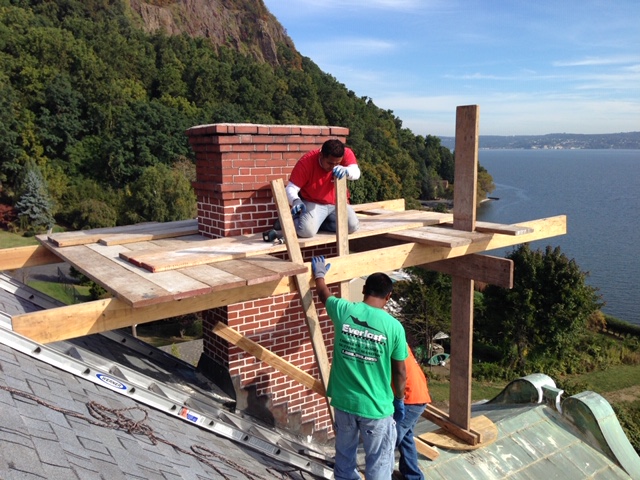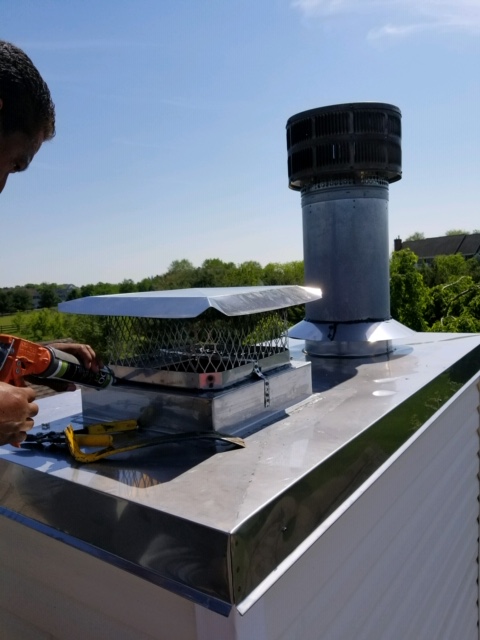A1 Everlast is a professional and highly reviewed chimney sweep & repair contractor in New Jersey. We offer all types of services associated with keeping your chimney clean, safe and working properly. From repairs like chimney cap replacement to chimney sweeping and chimney inspections, we’ll help you fast at affordable rates!
SAVE BIG! Please mention the special chimney offer of your choice when you contact us. View our chimney gallery
We Install, Repair, Clean and Reline Chimneys in NJ
There’s nothing better than building a fire in the hearth of a fireplace in those early fall months when the weather first begins to change. Those chilly evenings are the best time to bring that wonderful earthy smell into your home and use the fireplace as a source of ambiance and warmth.
Brick, like other masonry products, loses its integrity over time. If your chimney’s masonry decays over time – the bricks begin to crumble or birds and squirrels have come to roost, your chimney will quickly fall into disrepair.
Preserving your fireplaces aesthetic, keeping your family safe and insuring your fireplaces functionality is in top-notch condition, A1 Everlast, repairs, cleans and relines chimneys in New Jersey.
A1 Everlast Chimney Services:
- Residential Chimneys
- Chimney Repair
- Chimney Leak Repair
- Chimney Inspections
- Chimney Cleaning
- Chimney Sweep
- Chimney Liners
- Chimney Caps
A simple, but key, chimney inspection by A1 Everlast, an expert chimney contractor, will enable our qualified technicians to ascertain your chimney’s need. Whether it is a simple brick repair or a full replacement liner, we are poised to meet your needs.
If you need a chimney contractor for installation and repair in NJ, A1 Everlast can help. Our licensed and insured technicians are ready to service your chimney needs in Bergen, Passaic, Union, Essex, Morris, and Hudson counties n New Jersey.
Our Professional Chimney Services in NJ
Top 7 Reasons a Chimney Leaks
Homeowners often find themselves frustrated when faced with the problem of a leaking chimney. Not only does it compromise the structural integrity of the chimney, but it can also lead to water damage in surrounding areas. Understanding the various factors contributing to chimney leaks is crucial for effective identification and resolution of the issue. Below, we explore the top seven reasons why a chimney may develop leaks.
Damaged or Absent Chimney Crown:
A crucial component of the chimney, the chimney crown covers its top and serves as a vital defense against water intrusion. However, if the crown is cracked, deteriorated, or improperly constructed, it provides an entry point for water into the chimney structure. Likewise, in the absence of a chimney crown, rainwater can directly enter the chimney, resulting in leaks.
Cracked or Decayed Chimney Masonry:
Over time, exposure to harsh weather conditions causes the masonry materials of the chimney to deteriorate. The mortar joints holding the bricks or stones together may develop cracks, allowing water to penetrate the chimney. Furthermore, the bricks or stones themselves may become porous, further facilitating water intrusion.
Defective Flashing:
Flashing, a slim metal strip installed at the intersection between the chimney and the roof, plays a crucial role in creating a watertight seal to prevent water seepage into the roof and chimney joint. However, if the flashing is damaged, improperly installed, or has deteriorated over time, it fails to offer effective protection against water, leading to leaks.
Issues with the Chimney Cap:
The chimney cap acts as a protective cover over the chimney flue, safeguarding it against debris, animals, and rainwater. If the chimney cap is missing, damaged, or improperly fitted, it allows water to enter the chimney, leading to leaks. Regular inspection and maintenance of the chimney cap are essential to ensure its proper functioning.
Condensation Challenges:
Condensation can occur within the chimney, particularly when it lacks adequate insulation or when the flue gases are not properly vented. This condensation causes moisture buildup, resulting in leaks. Proper insulation and ventilation of the chimney system are key in preventing condensation-related leaks.
Chimney Settlement or Shifting:
Over time, the ground surrounding the chimney may settle or shift, causing misalignment or cracks in the chimney structure. These developments create gaps or openings through which water can enter, leading to leaks. Regular inspections for signs of settlement or shifting are vital in addressing structural issues promptly.
Improper Chimney Waterproofing:
Applying an appropriate waterproofing sealant to the exterior of the chimney is crucial in preventing water penetration. However, if the waterproofing material is incorrectly applied or if an unsuitable product is used, it fails to provide effective protection against water intrusion. Employing proper chimney waterproofing techniques ensures maximum effectiveness.




































